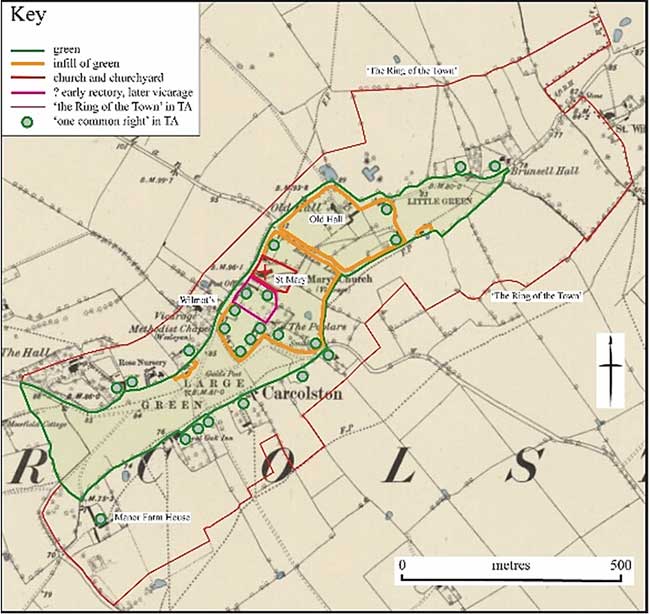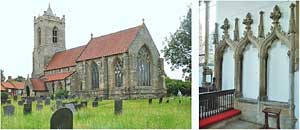Articles from the Thoroton Society Newsletter
The Rector’s Gift: Integrating church development and village landscape at Car Colston (Nottinghamshire) and elsewhere
Paul Everson and David Stocker
The Medieval Settlement Research Group’s successful annual conference in September 2015 at Leicester was held jointly with the Society for Church Archaeology. Its theme was to explore the relationship between church and village, and the value of combining studies of church fabric with those of their surrounding settlements. The conference outing visited four sites intended to illustrate variations on that theme and to provoke on-site discussion and debate. The last such visit was to Car Colston in Nottinghamshire (NGR SK720430), guided by the authors. An academic paper rounding up and expanding our discussions on that occasion has subsequently been prepared and published in the journal Church Archaeology. This note signposts that publication and offers a synopsis of its argument.

Figure 1. Car Colston, reconstruction of original green, with funnels eastwards onto access roads and widening westwards onto the heath along the Fosse Way: ‘the Ring of the Town’ and common rights as recorded in the 1843 Tithe award and apportionment (Nottinghamshire Archives Office, AT 26/ 5A, 5B). See Everson and Stocker 2014, Fig 3.
 Figure 2. Car Colston, church of St Mary from the southeast. Right: Car Colston, church of St Mary: chancel fittings -sedilia and piscina (Photos: authors). See Everson and Stocker 2014, Figs 1 and 2a
Figure 2. Car Colston, church of St Mary from the southeast. Right: Car Colston, church of St Mary: chancel fittings -sedilia and piscina (Photos: authors). See Everson and Stocker 2014, Figs 1 and 2aAnalysis of the unusual village plan of Car Colston identifies an original, very large green at its heart (Figure 1). St Mary’s church formerly sat on it; and the principal block of settlement encroachment, creating the latter-day pattern of two separate greens, lies adjacent to it. The church, on the other hand, is notable for its elaborate chancel and fittings of mid-14th century date (Figure 2). We identify this elaboration as the action of a last secular rector, as he transferred the rectory to Worksop Priory and became the living’s first vicar: it was ‘the rector’s gift’. We further propose that this change of status opened the way for the monastery to exploit its new asset at Car Colston by creating a block of properties adjacent to their former rectory, now vicarage, which became the core of the encroachment of settlement onto the green, observed in today’s landscape.
Further examples of similar ‘rector’s gifts’ are proposed at Heckington (NGR TF143441) and Great Hale (NGR TF148429), both Lincolnshire, and at Wharram Percy (NGR SE858642), Yorkshire East Riding, and the extent to which these examples of rebuilt 14th century chancels are accompanied by the expansion of settlement across former greens is considered.
It is concluded that the change of economic status embodied in a ‘rector’s gift’ -significant in its own right for its impact on church fabric and fittings - was sometimes a mechanism that initiated change in the physical form of the adjacent settlement, such as in-filling of greens.
The full published account of this study is: Everson, P. and Stocker, D. 2014. The Rector’s Gift. Integrating church development and village landscape at Car Colston (Nottinghamshire) and elsewhere. Church Archaeology 18: 65-80.
< Previous